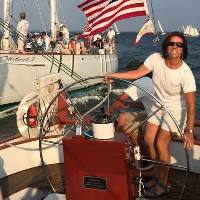
Captain Jennifer Kaye is one of four captains of the Woodwind, a 74-foot wooden schooner based in Annapolis, Maryland, that offers cruises on the Severn River and Chesapeake Bay.
Because Capt. Kaye and her crew want to give their visitors an enjoyable and safe experience on the water, she checks data—mostly from the Annapolis buoy—to help make important decisions before the Woodwind leaves the dock.
“We are constantly checking out the wind strength, direction, and even the trends. Sometimes we use the wave height and direction to make a determination if we might want to sail in the Bay or the Severn River. For example, if we know we have a wedding party and everyone is dressed up, we may sail up the Severn to avoid spray on the Bay from a strong southwest breeze making a choppy sea state of 3-4 foot waves.”
“Or if it's spring and the water temperature is still in the 50s, even a 80-degree day on land will turn into a much cooler day on the water, and we get our stadium blankets ready,” she noted, so they can keep their customers warm while they see Annapolis from the water.
While for most of the April through October season, the Woodwind and sister ship Woodwind II stick close to Annapolis for two-hour cruises and special events like weddings, on occasion they participate in the Great Chesapeake Bay Schooner Race, held each October, and then the team monitors conditions at buoys along the course.
“When we race down the Bay in the Great Chesapeake Bay Schooner Race, we definitely look at the data. Especially the Potomac River one. It’s so much quicker than waiting for the data and observations on the weather radio,” she said.
Because she also serves as the Woodwind’s general manager, Capt. Kaye is keenly aware of keeping her vessel safe, and CBIBS helps her do that. For example, when Hurricane/Superstorm Sandy made its way up the East Coast in October 2012, the crew stayed aboard the Woodwinds at a marina.
“It was nice to wake up and while still under the covers see if the wind had changed direction and if we needed to adjust dock lines or fenders. First thing I would do when I awoke is brought up the CBIBS data and looked at the trends of wind direction, speed and gusts. If any of that changed dramatically, I knew I had to get up and do a boat check quickly.”
As you might guess, with the sea that much in her blood, Capt. Kaye enjoys spending her time away from work on the water as well.
“I paddle board and kayak, so I like to know how clear the water is, and I like the new sea nettle probability feature. These will determine where I launch from and what course to take.”
We look forward to seeing Capt. Kaye on the water soon, no matter what kind of vessel she’s on!


